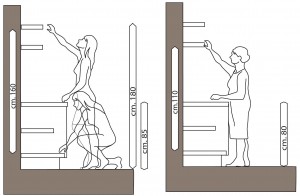Residential buildings for the elderly and the disabled
The progressive ageing of the population led to a demographic change involving economic, health- and care-related aspects of the society, as well as social and relational aspects.
Today, the Industrialised Countries’ policies tend to encourage their citizens to age at home, rather than changing accommodation or moving to long-term care facilities.
Generally, the need to resort to such facilities is due to the lack, or inadequacy, of a supportive social assistance network, to the houses which are no more suited to the needs of aged people or which are unfit for general equipment and general standards, which cannot easily fit the layout of rooms and/or plants, or are too big, therefore expensive and not easy to manage, isolated and far from access to basic needs services.
Therefore, houses, buildings and the neighborhood should become accessible with no physical or sensory barriers; moreover, they should be usable, comfortable, safe and equipped with technologies in support of both the households management and the management of different external services (e-medical examinations and management of health standards, etc.)
Finally, the urban context should provide a satisfactory level of assistance, services, recreational spaces and areas in which to socialise.
In addition to the ease of use of furnishings, spaces and technologies there is a strong focus on the flexibility of the domestic environment – the possibility to customize it gradually over the years, according to changes in the life of people: so, it is possible to have available customizable housings, tailored to the people’s life-style, regardless of their state of health and physical-sensory abilities.

